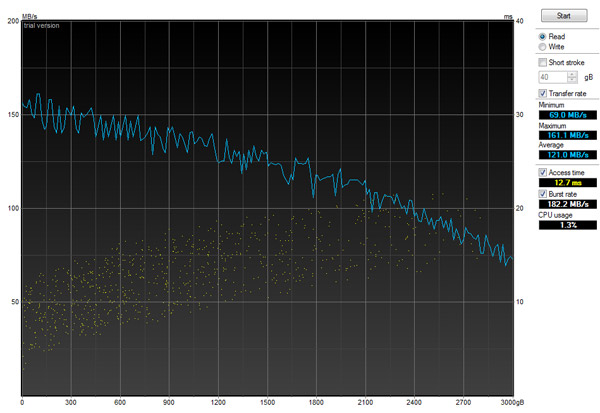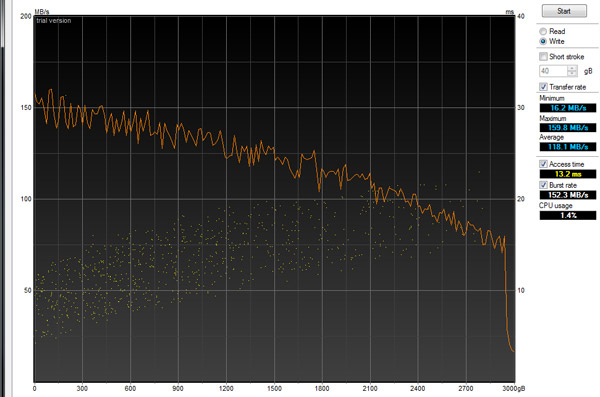The World's First 3TB HDD: Seagate GoFlex Desk 3TB Review
by Anand Lal Shimpi on August 23, 2010 12:39 AM EST- Posted in
- Storage
- Seagate
- HDDs
- GoFlex Desk
Performance vs. Capacity
I typically turn to HDTach for my performance vs. capacity graphs. Normally they are used to show SSD performance degradation without TRIM but in this case I genuinely wanted to see what the performance falloff was as you filled the drive up. HDTach had issues with the > 2TB of addresses on this drive so I used HD Tune instead.
Hard drives store data in circular patterns. Reading/writing to the outermost LBAs is faster (that’s just how circles work, you can cover more area in a single rotation on the outer track vs. the inner track). As a result, HDDs write data at the outmost part of the platters first and as the drive fills performance drops.
Sequential Read Performance vs. LBA

Sequential Write Performance vs. LBA

Peak performance, we’ve already discussed is at around 150MB/s over USB 3.0. Sequential performance at the highest LBAs drops to around 75MB/s. There’s one anomaly that I saw in my tests which you can see in the graph above. Performance drops down to 16.2MB/s for sequential writes in the last 100GB of the drive. This could be a problem with my particular drive or an issue related to the early nature of these 3TB drives.










81 Comments
View All Comments
Pastuch - Tuesday, August 24, 2010 - link
I am very confused on why the 3tb drives were not released as OEM. People looking for this kind of space are not looking to put the OS on that drive.Why not release the 3tb drives now, let us create GPT partitions in Windows and use the storage space. I need 12 terabytes ASAP! I would rather 4 drives instead of 6. Hopefully WD catches up soon.
Bytales - Wednesday, August 25, 2010 - link
I didn't knew long heat means performance degradation in such a way that it reaches the jaw-dropping 1mb/s.In these cases, flash ssd seem to have the advantage. However, we still have to wait until ssd become more capacitous than hdd, to the point that creating a hdd is no longer worth it.
loekf - Sunday, August 29, 2010 - link
Get a Western Digital MyBook 3.0, they only come in 1 TB and 2 TB flavours, but these keep itself cool. After copying 700 GB of data, temperate was steady at 43 celsius.mewgirl - Monday, January 31, 2011 - link
Except, don't, because they require a separate plug, are absolutely humangous (literally, about 3" in DEPTH!), and will last about 2 weeks.dragunover - Saturday, August 28, 2010 - link
Not.Seagate is terrible. In my own experience, it's been the only hard-drive out of many to fail. By far, I've had at least 4 Hitachi, 4 WD's, and a Samsung and none of them have failed. Then again, there's also the user-reported failure rates which report Seagate among the top...
MrSpadge - Saturday, September 4, 2010 - link
Hey Anand,you're doing a really great job on SSDs, but heres one paragraph I really disagree with:
"... and sequential performance is actually down from the 2TB drive due in part to the fact that we've got a smaller cache and generally less performance optimized drive with this external 3TB unit compared to the 2TB internal drive. Over USB 3.0 we actually get much better sequential performance apparently due to some additional buffering done by the USB 3 controller."
You're running into some bottleneck here using the internal SATA for the 3 TB drive. Was it in IDE mode? Or maybe just SATA1? If you take a look at the performance over capacity using this SATA port I bet you'll see a straight line at ~120 MB/s until about 1.5 TB and then a drop similar to what you're showing on the page "Performance vs. Capacity".
The reason is simple: on that page you're showing the drive hitting performance >120 MB/s over the entire first 1.5 TB using the USB 3 connection. This test is a sequential test over the entire drive, so ne pauses in between. Were this speed due to a buffer it had to be at least 1.5 TB big. Otherwise what you're seeing here is the real sequential performance of the drive.
And HDD caches influence real world benchmarks, but do not influence such sequential tests (think of it: even 64 MB are filled in just 0.5 s for such a drive, afterwards it's just plain "write them as fast as you can").
Best regards,
MrS
Rloew - Friday, October 1, 2010 - link
With some minor modifications to the MBR and FIlesystem code, the bare Hard Drive can be booted from without EFI and used in DOS and Windows 98SE. The USB 2.0 Interface can be used in Windows 98SE with a couple of Patches.Agent24 - Monday, October 18, 2010 - link
It makes no sense, unless they just didn't think to test what might happen to the drive temperature when stuck inside that little box and made to write data (who does that?)If it was cost, then that's stupid.
I expect these are quite expensive already, being new and 3TB. What's an extra $50 or whatever to get a decent case with some proper cooling vents or even a fan?
I definitely wouldn't buy one of these, not until they made a better case, and even then, I want to see the reliability of the drive itself.
The Sorcerer - Saturday, December 25, 2010 - link
On the 2 paragraph, 4th page you said:"While you can plug a SATA power cable directly into the drive, the enclosure prevents you from sticking a SATA data cable in there - not without trimming away part of the plastic surrounding the cable’s SATA connector at least."
You don't need to trim it. The SATA cable from the Asus boards are slightly thinner connectors. You should be able to do it. I've done it on the Seagate GoFlex 500GB PRO review:
http://www.hardwarebbq.com/2010/12/seagate-freeage...
Infact, when you run Crystal DIsk Information even when the drive is connected via USB mode, it detects the model but it will show that its scaled down to SATA 150 (I got a USB 2.0 as a sample).
Just my 2 cents :).
infoage2000 - Monday, July 21, 2014 - link
I have (or had) this 3 TB drive, and three months later it has died. The error; drive needs formatting. So in hopes it was the enclosure I bought a USB to SATA tester and have confirmed it is the drive. I knew better not to stray from the 1 and 1.5 TB drives which have always been reliable. The one lousy time I don't have backups for two directories I copied over....shaking my head in disgust.